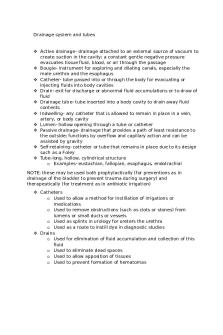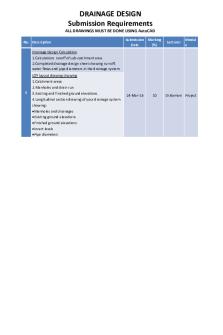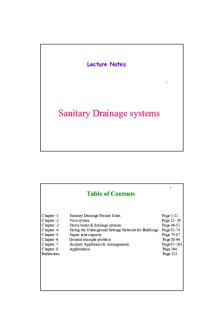Drainage system and tubes PDF

| Title | Drainage system and tubes |
|---|---|
| Author | Erin Freeman |
| Course | Fundamentals of Surgical Technology |
| Institution | Ivy Tech Community College of Indiana |
| Pages | 5 |
| File Size | 47.7 KB |
| File Type | |
| Total Downloads | 32 |
| Total Views | 152 |
Summary
This set of notes goes over the different drainage systems and tubes that can be used in surgery
...
Description
Drainage system and tubes
Active drainage- drainage attached to an external source of vacuum to create suction in the cavity; a constant gentle negative pressure evacuates tissue fluid, blood, or air through the passage Bougie- instrument for exploring and dilating canals, especially the male urethra and the esophagus Catheter- tube passed into or through the body for evacuating or injecting fluids into body cavities Drain- exit for discharge or abnormal fluid accumulations or to draw of fluid Drainage tube- tube inserted into a body cavity to drain away fluid contents Indwelling- any catheter that is allowed to remain in place in a vein, artery, or body cavity Lumen- hollow opening through a tube or catheter Passive drainage- drainage that provides a path of least resistance to the outside; functions by overflow and capillary action and can be assisted by gravity Self-retaining- catheter or tube that remains in place due to its design such as a Foley Tube-long, hollow, cylindrical structure o Examples- eustachian, fallopian, esophagus, endotrachial NOTE: these may be used both prophylactically (for preventions as in drainage of the bladder to prevent trauma during surgery) and therapeutically (for treatment as in antibiotic irrigation) Catheters o Used to allow a method for instillation of irrigations or medications o Used to remove obstructions (such as clots or stones) from lumens or small ducts or vessels o Used as splints in urology for ureters the urethra o Used as a route to instill dye in diagnostic studies Drains o Used for elimination of fluid accumulation and collection of this fluid o Used to eliminate dead spaces o Used to allow apposition of tissues o Used to prevent formation of hematomas
o Used to prevent wound margin necrosis by eliminating air pressure on uppermost margins of the wound which allows wound to heal from inside out o Used for gentle retraction of tissue during operative procedures to allow better visualization of the operative site o May be used to prevent abscess formation on trauma patients Tubes o Used to maintain an opening such as in the trachea o Used to decompress the gastrointestinal tract o Used to evacuate the pleural cavity and maintain a negative pressure so lungs can expand Placing and securing catheters, drains, and tubes Catheters and tubes o Gastrointestinal tubes and urinary catheters may be placed in body cavities pre, intra, and post operatively o Self-retaining catheters and tubes are held in place internally by an inflatable balloon o They are usually secured outside the body with tape depending on the doctor’s order Drains o Usually inserted intraoperatively by the surgeon o May be placed in the cavity and exteriorized through a separate wound called a stab wound o May be left free or attached securely with suture to the patient’s skin o The exposed end of the drain may or may not be attached to a reservoir or collecting system Types of drainage mechanisms Capillary action- movement of fluid along a solid object o Penrose drain Gravity- movement from high pressure to low pressure o Urinary catheters, t-tubes Manual suction- self contained negative pressure device o Hemovac, Jackson-Pratt External suction- machine or wall mounted o Salem sump, chest tubes Types of gastrointestinal tubes and their descriptions Levine tube- single lumen tube used for gastric decompression connected to gravity drainage or intermittent suction
o Sizes 14-18 French and 125 cm long o Used for stomach decompressing, withdrawing specimens, washing the stomach free or toxic substances, and irrigating the stomach and treat upper GI bleeds o Can be used to administer meds and/or feedings Sump tube- double lumen tubes used for gastric decompression connected to gravity drainage or constant suction o Most common nasogastric tube o Used for irrigation of stomach and tube feedings o Sizes 14-18 French o 120 cm long o If suction is needed, connect the larger bore to suction o Blue vent is always open to air for continuous atmospheric irrigation o Prevent reflux by having the blue vent port above patient’s waist Tracheal airway tubes o Tracheostomy tube Placed in a temporary or permanent opening in the trachea to allow air to enter the bronchi and lungs These tubes have three parts Obturator- provides a smooth tip during tube insertion to prevent trauma to the tracheal wall Primary tube (outer cannula)- maintains the patent airway Inner cannula- removable part that allows cleaning to prevent blockage of airway by crusting or secretions Has a built-in soft cuf that is inflated to eliminate any free space between the primary tube and the tracheal wall Endotracheal tube o Placed in the trachea to maintain a patent airway during loss of consciousness o These tubes are used for administration of anesthetics o These tubes are predominately the concern of anesthesia personnel o Adult tubes are cufed, and the cuf is inflated to allow snug fit of the tube as it extends into the trachea o Pediatric and infant tubes are non-cufed since pediatric patient’s tracheas are smaller and might be damaged by snug fitting tubes o These tubes require no collecting device; however, oxygen may be administered via the tube and respiratory secretions may need to be removed by suctioning
Pharyngeal airway tube o Inserted through the mouth and extends through the oral pharynx o Maintains airway by preventing patient’s tongue from falling back into the oral pharynx Nasal airway tube o Inserted through the nasal passage and extends through the oral pharynx o Maintains an open nasal airway when mucus membranes may be swollen or when patient has had extensive oral surgery Chest tubes and their characteristics Chest tubes are used to evacuate hemothorax, pneumothorax, or hemopneumothorax, and to drain pleural abscess or empyema Chest tubes are required on most cases in which the thoracic cavity is entered If two chest tubes are used, one is placed higher in the chest for evacuation of air, and the other is placed lower for evacuation of blood and serious drainage These tubes are always connected to an underwater sealed drainage system which may be connected to suction Underwater sealed drainage is available as o Self-contained, plastic, disposable unit o Glass- bottle system which may consist of 1, 2, or 3 bottles Self-contained drainage system units are known as pleur-evac or Thora-seal For units that are not self-contained, a gomco or an emerson pump is frequently used for suction source Types of wound drains and their uses Penrose drain- used to drain abscess cavity and if leakage is anticipated; no collection device needed since allowed to drain onto dressings Cigarette drain- used as a Penrose, but gauze allows for wick actions on accumulated fluid T-tube- used after common bile duct exploration to ensure patency of duct; connected to bile bag and drained by gravity Malecot or pezzer catheter- used to drain hollow organs such as bladder, may be used as gastrostomy tube, and may be placed in large abscess site; connected to drainage bag and drained by gravity
Hemovac- used to drain wound after extensive dissection or where moderate to large amounts of drainage are expected; has selfcontained collecting device and manual suction Jackson-pratt-used to drain wound where small to moderate amounts of drainage are expected; has self- contained collecting device and manual suction Common types of urethral catheters Urethral catheters come in various French sizes from 6 fr to 30 fr with varying sizes of inflatable balloons measured in cc’s Non retaining o Robinson (plain) (red rubber) (robnel) o Coude o Whistle tip o Multieyed o Self- retraining (indwelling) o Two-way (double channel) Foley o Three-way (triple lumen) Foley o Pezzer (mushroom) o Malecot (2 or 4 winged) o Look at page 285 in AST book for more details about these ...
Similar Free PDFs

Drainage system and tubes
- 5 Pages

Gastric and intestinal tubes
- 5 Pages

Drainage
- 7 Pages

C27- chest trauma and tubes
- 18 Pages

Chest Tubes
- 3 Pages

Capillary Tubes
- 4 Pages

Drainage Design
- 43 Pages

Makalah tubes meka
- 14 Pages

Tuberville v Savage - tubes
- 1 Pages

Feeding tubes admin/assessment
- 5 Pages

Pitot Tubes Majer
- 8 Pages
Popular Institutions
- Tinajero National High School - Annex
- Politeknik Caltex Riau
- Yokohama City University
- SGT University
- University of Al-Qadisiyah
- Divine Word College of Vigan
- Techniek College Rotterdam
- Universidade de Santiago
- Universiti Teknologi MARA Cawangan Johor Kampus Pasir Gudang
- Poltekkes Kemenkes Yogyakarta
- Baguio City National High School
- Colegio san marcos
- preparatoria uno
- Centro de Bachillerato Tecnológico Industrial y de Servicios No. 107
- Dalian Maritime University
- Quang Trung Secondary School
- Colegio Tecnológico en Informática
- Corporación Regional de Educación Superior
- Grupo CEDVA
- Dar Al Uloom University
- Centro de Estudios Preuniversitarios de la Universidad Nacional de Ingeniería
- 上智大学
- Aakash International School, Nuna Majara
- San Felipe Neri Catholic School
- Kang Chiao International School - New Taipei City
- Misamis Occidental National High School
- Institución Educativa Escuela Normal Juan Ladrilleros
- Kolehiyo ng Pantukan
- Batanes State College
- Instituto Continental
- Sekolah Menengah Kejuruan Kesehatan Kaltara (Tarakan)
- Colegio de La Inmaculada Concepcion - Cebu




